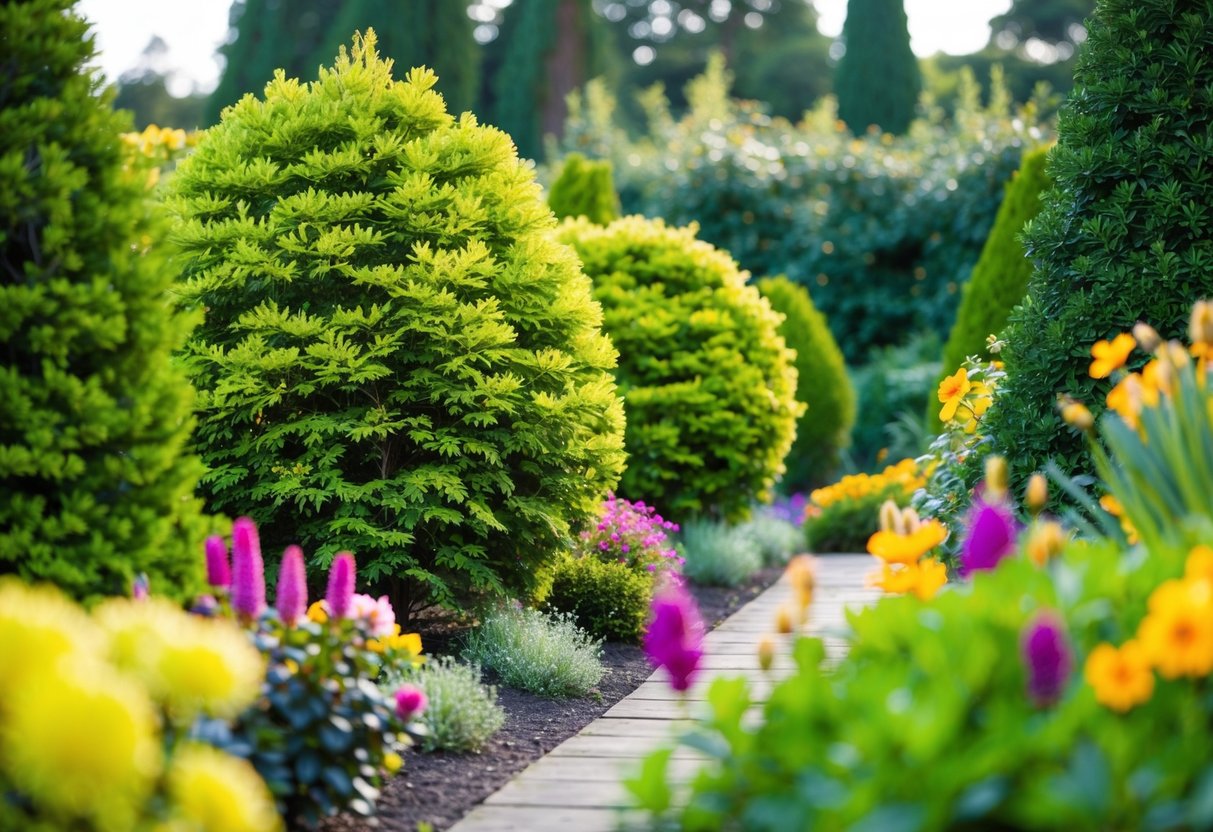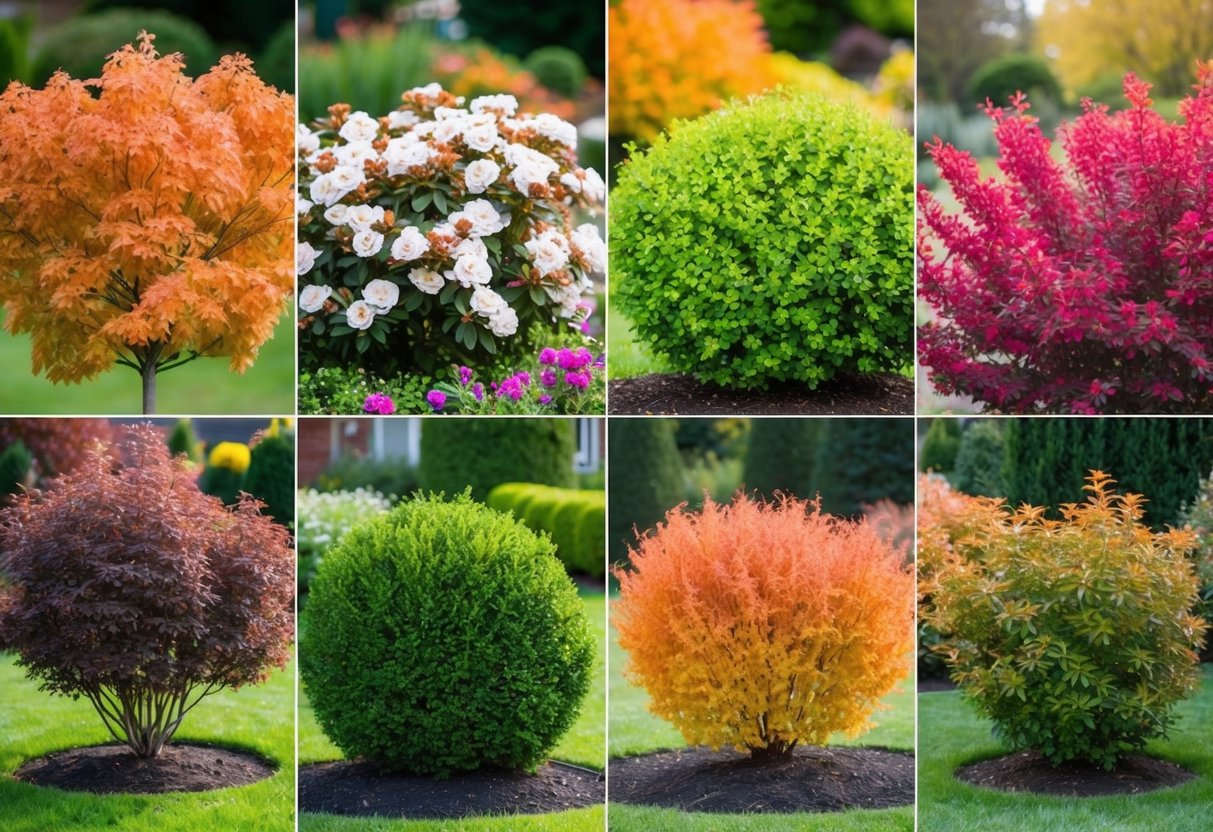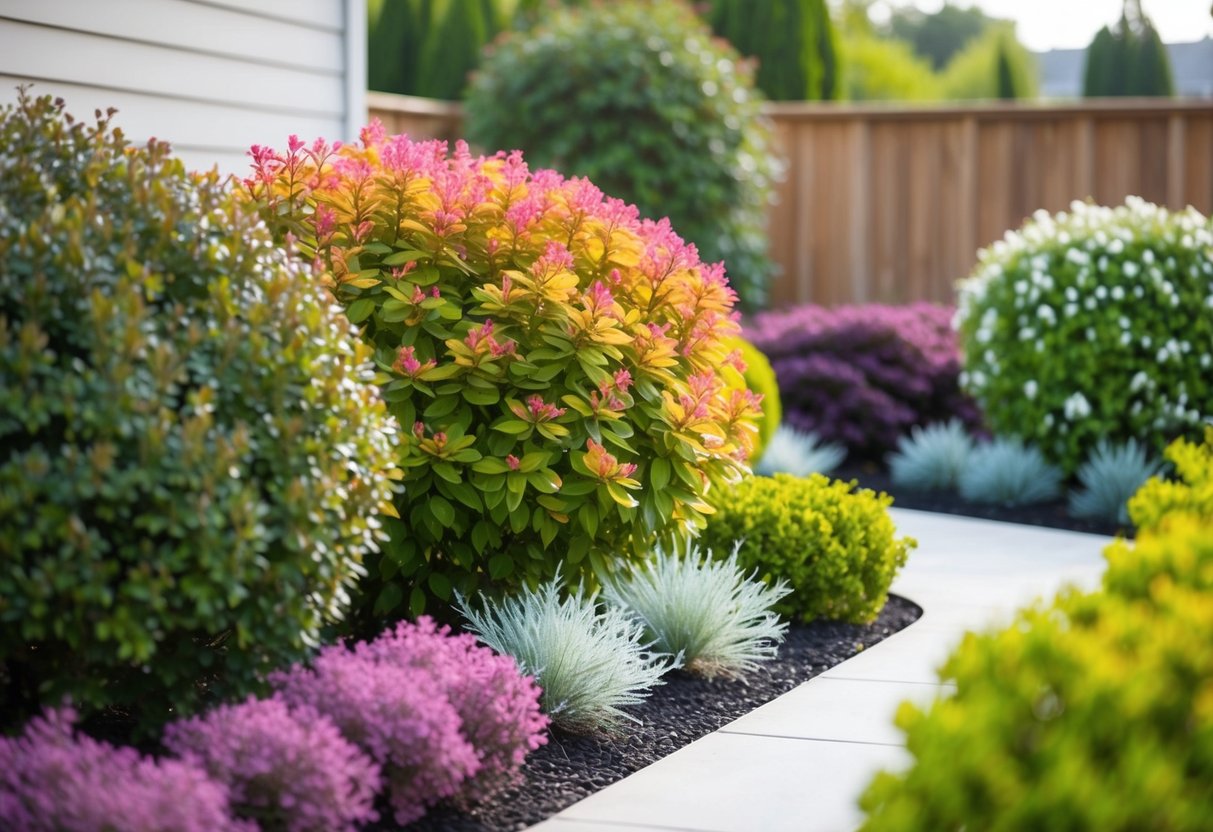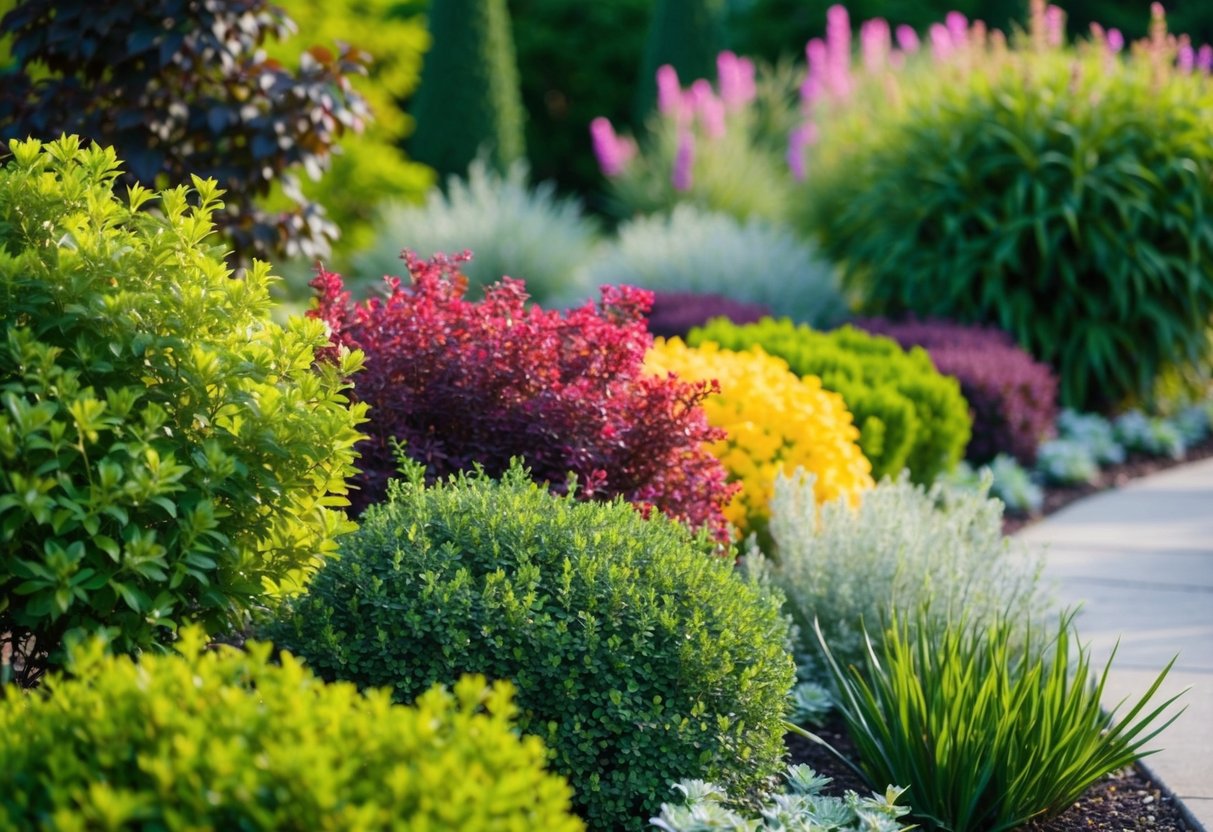What are Low-Maintenance Colorful Shrubs All Year Round? Discover Vibrant Choices for Every Season
Are you looking to brighten up your garden without spending too much time on upkeep? There are many shrubs that offer vibrant colors all year round and require little effort to maintain. Low-maintenance plants like the Bird’s Nest spruce can thrive on neglect while adding charm to your garden.

Evergreen shrubs are a fantastic choice if you want continuous color. The Sprinter boxwood, for example, offers glossy foliage that stays attractive, making it perfect for edges and pathways.
You’ve also got options like Japanese pieris, known for its stunning spring blooms. With these shrubs, your garden can stay lively and colorful throughout the year, with minimal fuss.
Choosing the Right Shrubs for Your Garden

Choosing shrubs that bring color throughout the year requires careful consideration. You should think about the climate you live in and the lighting and soil conditions in your garden. These factors help you find shrubs that will thrive and look beautiful in your space.
Understanding Plant Hardiness Zones
When selecting shrubs, you first need to understand plant hardiness zones. These zones tell you which plants are most likely to survive in your area. For example, if you live in a colder zone, choose shrubs that can handle lower temperatures, like certain types of hawthorns which thrive on neglect but need the right conditions.
It’s useful to check the USDA Plant Hardiness Zone Map to know what can grow well in your region. By choosing plants suited to your zone, like Wynyabbie Gem that withstand coastal winds, you can ensure your garden remains colorful all year. Matching your plant choices to your zone will save you time and effort as the plants will be easier to maintain.
Evaluating Sunlight and Soil Conditions
Next, it’s important to evaluate the sunlight your garden receives. Some shrubs, like gardenia, prefer full sun to partial shade. Observing your garden throughout the day helps in understanding how much direct sunlight different areas get. Full sun areas might suit different plants than those in partial shade.
Soil conditions also play a big role. Well-drained soil is crucial for many low-maintenance shrubs like the Indian hawthorn. Test your soil’s drainage by seeing how quickly water absorbs after a rain. If needed, amend the soil with materials like compost to improve drainage and nutrient levels.
By focusing on suitable sunlight and soil, you set up your shrubs for success. Adapt your choices based on these factors to ensure vibrant colors all year round in your garden.
Evergreen Shrubs for Year-Round Interest

Evergreen shrubs can bring vibrant color to your garden throughout the year. From the classic holly to versatile boxwood, these shrubs offer beauty and minimal upkeep. Explore these options to find what fits your needs best.
Holly Varieties
Hollies are known for their glossy green leaves and bright red berries, offering a festive look in winter. Different types like Blue Holly and Japanese Holly provide variety in leaf shape and berry color. They are generally easy to care for, requiring little pruning while being hardy in various climates. Hollies also serve as natural windbreakers and attract birds with their berries. They thrive in full sun to partial shade, making them versatile.
Boxwood and Its Versatility
Boxwoods are popular for their ability to be shaped into hedges, balls, or other forms. Sprinter® Boxwood is a fast-growing option that maintains its glossy green leaves all year long. These shrubs are suitable for borders and are deer resistant, which is a great plus. They thrive in full sun to full shade and are hardy in zones 5-9. You’ll find that boxwoods require little maintenance, with occasional trimming to keep the desired shape.
Juniper Selections
Junipers bring a range of textures with their needle-like foliage that can be blue-green to silvery in color. They are excellent for ground cover or as stand-alone accents in a garden. Offering both vertical and horizontal growth patterns, junipers can fit almost any landscape design. Like other evergreens, they are low-maintenance and drought-tolerant once established. Their aromatic foliage also helps deter pests.
Rhododendron and Azaleas
For pops of color, rhododendrons and azaleas are perfect choices. These shrubs bloom in spring with stunning flowers, while retaining their leaves through the year. Selections come in white, pink, red, and purple, adding vibrancy to any garden. These plants prefer acidic soil and need protection from harsh afternoon sun. Although they require some specific conditions, they repay with stunning visual rewards when in bloom.
Colorful Shrubs for Each Season

Discover how shrubs can brighten your garden throughout the year. From vivid spring blooms to winter berries, there’s always something to enjoy. Whether it’s the cheerful yellow of forsythia or the rich tones of oakleaf hydrangea in autumn, each season has its own stars.
Spring Flowers and Foliage
In spring, forsythia is one of the first to bloom, boasting bright yellow flowers that make your garden pop. Following close behind are lilacs, offering wonderful scents and lovely purple or white blossoms. Witch hazel also stands out with its unique spidery flowers that can range from yellow to red. These choices keep your garden lively as winter fades away.
Consider planting forsythia and lilac near paths or doorways where you can easily enjoy their colors and fragrances. Both adapt well to many soil types, making them versatile options for many gardens. Pruning after blooming keeps these shrubs looking tidy and encourages new growth.
Summer Blooms and Growth
Summer brings lush foliage and spectacular blooms. Rose of Sharon is a favorite during this season. It produces large, bright flowers in shades of white, pink, and purple. It thrives with lots of sunlight, adding cheer to sunny areas of your garden.
During this time, shrubs like the oakleaf hydrangea reveal their beautiful leaves and big flower clusters. Their colors can shift from creamy whites to deep reds as the season progresses. These shrubs provide not just color but also structure to your garden spaces.
Autumn Colors and Textures
Autumn is the time for oakleaf hydrangea and fall foliage that displays rich shades of red and orange. These shrubs are exceptional for their striking autumn tones. They make your garden look warm and inviting as temperatures drop.
Beautyberry is another great option, known for its eye-catching purple berries, which add an interesting texture to your garden in the fall. Plant these in groups where you can observe their transformation up close. You might also consider other plants like sumac for great fall visuals.
Winter Interest with Berries and Bark
Even in winter, your garden can offer beauty. Shrubs like witch hazel keep things lively with unusual winter blooms. Bark becomes more noticeable, with colors and textures providing engaging visuals when everything else seems dormant.
Beautyberry continues to shine with its purple berries that last well into winter. These berries are not only attractive but can also provide food for birds. Combining shrubs such as these ensures your garden maintains interest, even in the coldest months. Adding a mix of evergreen and deciduous shrubs gives balance and variety.
Low-Maintenance Tips for Shrub Care

Caring for shrubs year-round doesn’t have to be hard. With proper pruning, watering, and pest control, your shrubs can stay healthy and beautiful.
Pruning and Shaping
Pruning helps keep your shrubs in good shape. Begin by cutting back dead or damaged branches. This keeps the plant healthy and lets it focus on growing new parts. Dwarf shrubs often require less pruning, which makes them ideal for low-maintenance gardens.
When shaping your shrubs, think about the natural form. You can do this once a year, usually in late winter or early spring. This timing helps promote new growth in the growing season. For foundation plantings, trim them just enough to keep their shape without overdoing it.
Watering and Mulching
Watering is critical for shrub health. It’s best to water deeply but infrequently. This encourages roots to grow deeper, making plants more resistant to drought. Aim to water in the morning to let moisture reach the roots before the sun evaporates it.
Mulching can save you time and effort. A two to three-inch layer of mulch around your low-maintenance shrubs helps retain soil moisture. It also keeps weeds at bay and adds nutrients as it decomposes. Choose organic mulches like shredded bark or wood chips for best results.
Dealing with Pests and Diseases
Keeping your shrubs free of pests and diseases is key, but it’s not difficult. Start by inspecting leaves and stems regularly for signs of trouble. Some pests, like aphids, can be washed off with a strong water spray.
If you notice disease symptoms, like discolored leaves, consider using organic sprays as a first step. Low-maintenance shrubs are often more resistant to problems, requiring less intervention. Regular care, like tidying up fallen leaves, can also prevent many issues before they start.
Incorporating Shrubs into Landscape Design

When adding low-maintenance colorful shrubs to your garden, it’s important to consider how they can be used to enhance various areas. Whether as foundation plantings, privacy screens, or specimen plants, these shrubs can play different roles in your landscape.
Foundation Plantings and Borders
Using shrubs for foundation plantings and borders can give your garden structure and color. These plantings are placed near the base of buildings, forming a harmonious connection between the architecture and the landscape. Evergreen shrubs like the Bird’s Nest Spruce are ideal for this purpose due to their compact shape and year-round greenery. Additionally, shrubs with vibrant colors can add visual interest. For example, the common ninebark shrub has deep red leaves that contrast beautifully with its white flowers.
Creating Privacy Screens and Hedges
Privacy screens and hedges made from shrubs can create secluded spaces in your garden. Texas ranger shrubs are a great choice here. They have dense foliage and can grow several feet tall, providing excellent coverage. These shrubs can function as effective privacy screens. Shrubs like the Black Chokeberry not only deliver privacy but also showcase beautiful red-purple fall foliage while producing shiny black fruits.
Specimen Plants and Focal Points
Specimen plants are meant to stand out and capture attention in your garden. When you choose a shrub as a focal point, consider one that offers unique features throughout the year. For instance, the Texas ranger shrub’s purple flowers and silvery leaves make it highly attractive. Placing a specimen plant in the center of a lawn or beside a pathway highlights its beauty and draws the eye. Using shrubbery with contrasting colors and textures against simpler landscapes can create eye-catching focal points.







